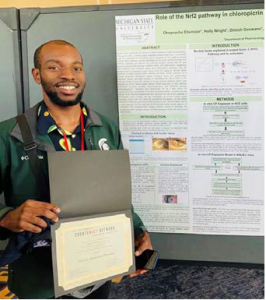2024 Awards
Andrew Roney – Graduate Student
Society of Toxicology Dermal Toxicology Specialty Section Edgewell Personal Care Student Award
Shruti Veluru – Undergraduate Student
1st place poster award at ASPET 2024.
2023 Awards
Omid Madadgar-Master’s student
2023 Dermal Toxicology SS Edgewell Personal Care Student and Postdoctoral Award
Title: “Phosgene Oxime Skin Exposure Causes Oxidative Damage to Biomolecules Including Lipids, Proteins, and DNA in Murine Skin Model”
Andrew Roney-Graduate Student
MSU College of Osteopathic Medicine Research Day
2nd place in the Resident, Fellow, Trainee Poster Presentation competition.
Ebenezar Okoyeocha-Graduate Student
2023 Ocular Toxicology SS Best Poster Award
Title: “Progression of chloropicrin induced ocular injury: clinical and biological effects”
2023 Ocular Toxicology SS Graduate Student and Postdoctoral Fellow Trainee Support Award
Ellen Kim-Undergraduate Student
ASPET travel award to the 2023 Annual Meeting in St. Louis, Missouri
Poster Title: “Cutaneous Exposures to Nitrogen Mustard in C57BL/6 Mice Cause Hematologic Toxicity that could lead to Acute and Long-term Effects”
2022 Awards
 Ebenezar Okoyeocha, EITS student training with Dr. Neera Tewari-Singh, received a travel award for his presentation in the 15th Annual CounterACT Network Research Symposium in New Orleans, Louisiana, in June 2022. The symposium was organized by the National Institute of Environental Health Sciences, the National Institute of Allergy and Infectious Diseases and the National Institute of Health Office of the Director. Okoyeocha spoke on, “The Role of Nrf2 Pathway in Chloropicrin Induced Ocular Toxicity in Human Corneal Epithelial Cells and Mice.” (IIT Newsletter, October 2022).
Ebenezar Okoyeocha, EITS student training with Dr. Neera Tewari-Singh, received a travel award for his presentation in the 15th Annual CounterACT Network Research Symposium in New Orleans, Louisiana, in June 2022. The symposium was organized by the National Institute of Environental Health Sciences, the National Institute of Allergy and Infectious Diseases and the National Institute of Health Office of the Director. Okoyeocha spoke on, “The Role of Nrf2 Pathway in Chloropicrin Induced Ocular Toxicity in Human Corneal Epithelial Cells and Mice.” (IIT Newsletter, October 2022).
Ellen Kim-Undergraduate Student
Michigan SOT Meeting
Ellen Kim receive second place in the undergraduate poster presentation category for presenting Hematological Consequences of Dermal Exposure to Chemical Threat Agent. Fourth place went to Madeline Godziela for Lung Injury following cutaneous Phosgene Oxime Exposure in SKH-1 Hairless Mice.
Maddie Godziela – Undergraduate Student
Fall 2022 Meeting of the Michigan Chapter of the Society of Toxicology
Fourth place for Outstanding Poster, Lung Injury following cutaneous Phosgene Oxime Exposure in SKH-1 Hairless Mice.
2021 Awards
Dr. Neera Tewari-Singh
Society of Toxicology-Ocular Toxicology Specialty Section Ocular Toxicology I2 Award (Innovation and Impact) Sponsored by Biomere. This award recognizes innovations and/or scientific advances that Impact the field of ocular toxicology based on papers published.
Dr. Satyendra Singh
Society of Toxicology-Dermal Toxicology Specialty Section, Stratacor Postdoctoral Award. Awarded to Postdoctoral candidates for their contribution to skin-related research.
Dr. Swati Sharma
Society of Toxicology-Dermal Toxicology Specialty Section Postdoctoral Award Sponsored by Charles River. Awarded for skin-related toxicology research.
Ryan Kerin
American Physician Scientists Association Fall Research Conference. Awarded 1st Place in Best Poster Competition.